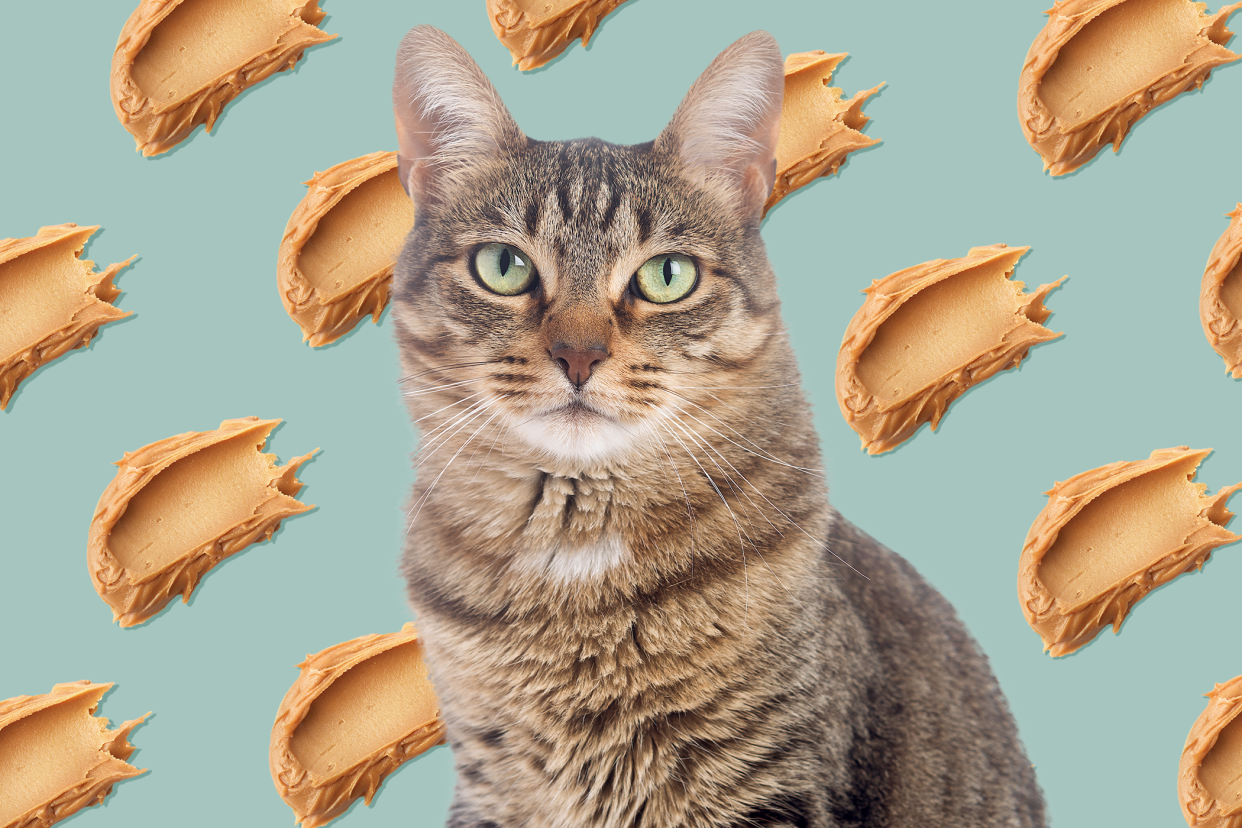Is Peanut Butter Lip-Smacking Good for Cats? It's Complicated

LumenSt / Chuyn / Getty
Peanut butter is a popular treat for dogs, so you may be wondering if your cat can eat peanut butter, too. The short answer is yes—cats can eat peanut butter. But before you give your cat a spoonful, there are other questions to consider: Are there any nutritional benefits to feeding cats peanut butter? Are there any risks involved with feeding cats peanut butter? How can cats be fed peanut butter safely? Answering these requires a quick overview of feline nutrition and some expert advice on how to partner with your veterinarian to keep your cat healthy.
Are There Nutritional Benefits to Feeding Cats Peanut Butter?
According to the University of Missouri Small Animal Clinical Nutrition Service in Columbia, Mo., cats have specific nutrient requirements that must be met by their diet, and the nutrients they require aren't the same as the ones humans need. As obligate carnivores, cats rely on nutrients found only in animal products. "The simplest and most convenient way to meet the nutrient requirements of a cat," the Clinical Nutrition Service explains, "is to provide them with a complete and balanced commercial diet formulated by a board-certified veterinary nutritionist or an individual with a PhD in animal nutrition."
This means as long as your cat is getting all of his required nutrients from his diet, treats like peanut butter don't have nutritional benefits. It's also important to note that when it comes to nutrients, more isn't always merrier. In some cases, giving a cat more nutrients than he needs can actually cause problems.
Are There Any Risks Involved with Feeding Cats Peanut Butter?
While the Clinical Nutrition Service lists peanut butter as a safe food for cats, it notes that there are caveats, including the ones listed below.
Peanut butter is considered to be safe for healthy cats. So if your cat has a health condition, the general rule doesn't apply.
Every cat is unique and can vary a great deal when it comes to tolerating certain foods. "Cats must be considered individually," the Clinical Nutrition Service explains, "as some cats may consume a particular food item with no issue and another cat may consume the same item and develop vomiting, diarrhea, or other adverse signs."
The majority of a cat's calories should come from foods specially formulated to give him the nutrients he needs. Human foods like peanut butter should only be given occasionally and in moderation.
Due to its thick, sticky consistency, peanut butter can be a choking hazard for cats.
Peanut butter often contains a sweetener called xylitol that is toxic to cats. Xylitol can cause vomiting, lethargy, and loss of coordination and signs can progress to seizures and liver failure. The simpler the butter, the better. Always check the nutrition label, and aim for a butter containing only peanuts.
If you know or suspect your cat has eaten peanut butter sweetened with xylitol, call your veterinarian or the ASPCA Animal Poison Control Center (888-426-4435) as soon as possible.
How Can I Feed My Cat Peanut Butter Safely?
With these caveats and feline nutritional needs in mind, here are some general rules to follow when feeding your cat peanut butter:
Ask. Talk to your veterinarian before giving your cat any new human foods—even if they're typically considered to be safe for pets.
Calculate. To determine how much peanut butter your cat can safely eat, you'll need to do a little math. The Clinical Nutrition Service says treats shouldn't account for more than 10 percent of your cat's daily caloric intake. For example, if your cat eats 250 calories a day, only 25 of those calories should come from treats. Check the nutrition label on your peanut butter jar to see the calorie count per tablespoon. Peanut butter is calorically dense, so the correct portion size should be very small. This is also a good time to double-check the ingredient list to make sure it doesn't contain anything your cat should avoid—especially xylitol. Cats vary in the amount of food they need to eat each day to maintain an ideal weight. If you aren't sure how many calories your cat needs or what his ideal weight is, ask your veterinarian about developing a nutrition plan that's specific to your cat.
Monitor. The Clinical Nutrition Service says that even safe foods can have unexpected reactions, so watch your pet for signs of gastrointestinal problems (e.g. vomiting, diarrhea) after consuming a new food. It's also a good idea to introduce only one new food at a time. That way, if your cat does start showing signs of illness, you can more easily pinpoint the source of the problem. If you think your cat is having an adverse response to peanut butter, call your veterinarian.
Should Cats Eat Peanut Butter?
The bottom line: nutrients before treats. Because peanut butter isn't part of a complete and balanced diet for felines and because it can cause problems, there's no need to go out of your way to get your cat to eat it. However, if your cat is curious or you think a bit of peanut butter might help some medicine go down, follow the guidelines above for the safest approach.
If you're unsure whether your cat is getting the nutrients he needs from the food he eats every day, bring up your concerns with your veterinarian. They are ready to help you find good options for your pet. And if you're sensing a theme about going to your veterinarian with questions, it's intentional. Open, honest communication with your veterinarian is key to keeping your cat safe and healthy. No problem (or treat) is too small to discuss.

